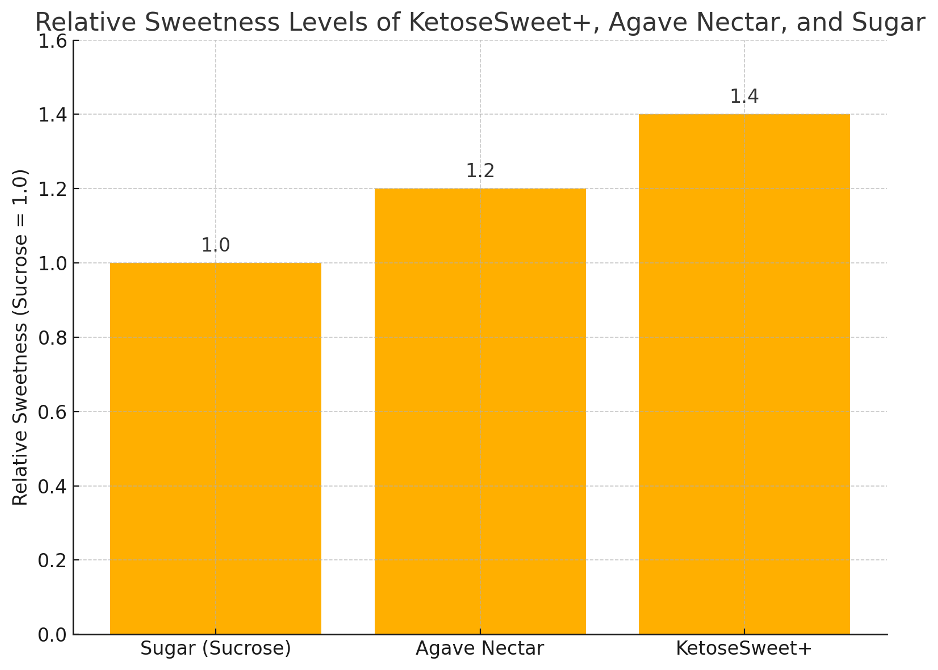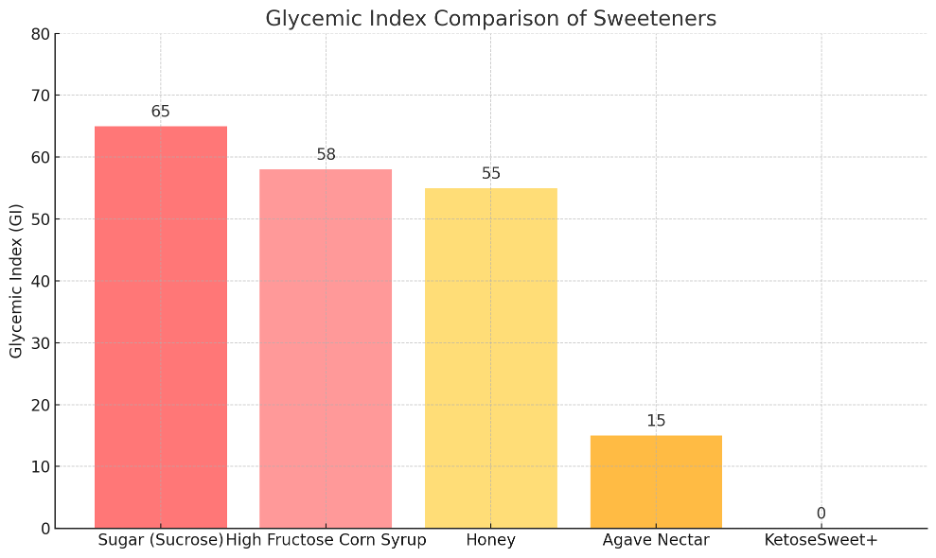by Thom King, Icon Foods, Chief Innovations Officer/Food Scientist
KetoseSweet+ by Icon Foods: A Comprehensive Overview for Food Scientists
by Thom King, Icon Foods, Chief Innovations Officer/Food Scientist
The demand for natural, low-calorie sweeteners has surged as consumers seek healthier alternatives to sugar. Icon Foods addresses this need with KetoseSweet+, a proprietary blend of allulose, stevia, and monk fruit extracts. This combination offers a synergistic approach to sugar replacement, balancing sweetness, functionality, and health benefits.
Composition and Synergy
Allulose: A rare sugar found in foods like wheat, figs, and jackfruit, allulose provides approximately 70% of the sweetness of sucrose but with only 0.2–0.4 kcal/g. It is not metabolized by the body, making it nearly calorie-free and non-glycemic .
Stevia: Derived from the Stevia rebaudiana plant, stevia is a high-intensity sweetener, approximately 200–300 times sweeter than sugar. It contributes zero calories and has been recognized for its safety and stability in various applications .
Monk Fruit (Luo Han Guo): Monk fruit extract contains mogrosides, which are intensely sweet compounds. Like stevia, it is calorie-free and does not impact blood glucose levels .
The combination of these three sweeteners in KetoseSweet+ leverages their individual strengths, resulting in a balanced sweetness profile that closely mimics that of sucrose. Allulose provides bulk and mouthfeel, while stevia and monk fruit enhance sweetness intensity and help mask each other’s aftertastes.

See the above graph comparing the sweetness curves of KetoseSweet+, agave nectar, and sugar (sucrose). It illustrates how KetoseSweet+ delivers a consistent and efficient sweetness perception across concentrations, while agave nectar and sugar show more linear or slightly diminishing returns.
Functional Benefits in Food and Beverage Formulations
• Sugar-Like Sweetness and Mouthfeel: KetoseSweet+ delivers a sweetness profile comparable to sugar, with the added benefit of a clean taste and minimal aftertaste. Allulose contributes to the bulk and mouthfeel, essential in applications like baked goods and confections.

This bar chart compares the relative sweetness levels of KetoseSweet+, agave nectar, and sugar. KetoseSweet+ is shown to be approximately 40% sweeter than sugar by weight, offering a potent sweetness profile ideal for sugar reduction.
• Thermal Stability: The blend exhibits excellent stability under heat, making it suitable for baking and cooking processes. Allulose participates in Maillard browning reactions, contributing to desirable color and flavor development in baked products.
• Solubility and Compatibility: KetoseSweet+ dissolves readily in aqueous solutions, ensuring uniform sweetness in beverages and syrups. Its compatibility with other ingredients makes it versatile across various food matrices.
• Glycemic Control: The components of KetoseSweet+ do not raise blood glucose or insulin levels, making it an ideal sweetener for diabetic-friendly products.

This chart illustrates the glycemic index (GI) of various sweeteners. KetoseSweet+ stands out with a GI of 0, making it an ideal choice for blood sugar management compared to sugar, HFCS, honey, and agave nectar.
Health and Regulatory Considerations
• Caloric Content: Allulose provides about 0.2–0.4 kcal/g, significantly lower than sucrose. Stevia and monk fruit are non-caloric, contributing to the overall low-calorie profile of KetoseSweet+.

See the chart above comparing the calorie content per gram of KetoseSweet+ against sugar, high fructose corn syrup, honey, and agave nectar. KetoseSweet+ offers significant calorie reduction, making it ideal for low-calorie and ketogenic formulations.
• Digestive Tolerance: Unlike some sugar alcohols, allulose is well-tolerated and does not cause gastrointestinal discomfort at typical consumption levels.
• Regulatory Status: All components of KetoseSweet+ have been recognized as Generally Recognized as Safe (GRAS) by the FDA. Notably, allulose is exempt from being listed as an added sugar on Nutrition Facts labels, providing labeling advantages for manufacturers.
Application Examples
Baked Goods: KetoseSweet+ can replace sugar in cookies, cakes, and pastries, providing similar sweetness and contributing to browning and texture.
Beverages: Its high solubility and clean taste make it suitable for sweetening teas, coffees, and flavored waters without altering flavor profiles.
Dairy Products: In yogurts and ice creams, KetoseSweet+ offers sweetness without adding calories, aligning with consumer demand for healthier options.
Confections: It enables the production of sugar-free candies and chocolates that maintain the desired sweetness and mouthfeel.
Available in syrup and various crystalline particle sizes, KetoseSweet+ by Icon Foods presents a scientifically backed, versatile sweetening solution for food and beverage manufacturers aiming to reduce sugar content without compromising on taste or functionality. Its blend of allulose, stevia, and monk fruit offers a synergistic approach to sweetness, aligning with current health trends and regulatory frameworks.
—
Since 1999 Icon Foods has been your reliable supply chain partner for sweeteners, fibers, sweetening systems, inclusions and sweetness modulators.
Reach out to your Icon Foods representative for KetoseSweet+ crystalline or syrup samples, documentation and formulations guidance.
Taste the Icon difference.